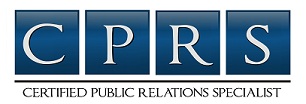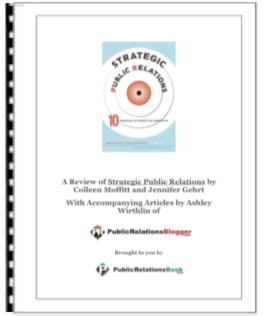________________________________________________________________________
 As a manager, does your current business, non-profit or association public relations effort concern itself primarily with radio and newspaper publicity? Or does it concentrate on a specialty area like financial communications or trade relations? Or, possibly, it deals each day with sales support or government affairs?
As a manager, does your current business, non-profit or association public relations effort concern itself primarily with radio and newspaper publicity? Or does it concentrate on a specialty area like financial communications or trade relations? Or, possibly, it deals each day with sales support or government affairs?
Actually, maybe your PR effort should concentrate on delivering what you really need?
For example, PR that really does something positive about the behaviors of those outside audiences that most affect your organization?
PR that uses its fundamental premise to deliver external stakeholder behavior change - the kind that leads directly to achieving your managerial objectives?
And PR that persuades those important outside folks to your way of thinking, then moves them to take actions that help your department, division or subsidiary succeed?
What fundamental PR premise are we suggesting as your new action blueprint? People act on their own perception of the facts before them, which leads to predictable behaviors about which something can be done. When we create, change or reinforce that opinion by reaching, persuading and moving-to-desired-action the very people whose behaviors affect the organization the most, the public relations mission is accomplished.
The results can be very satisfying: membership applications on the rise; customers starting to make repeat purchases; fresh proposals for strategic alliances and joint ventures; community leaders beginning to seek you out; welcome bounces in show room visits; prospects starting to do business with you; higher employee retention rates, capital givers or specifying sources beginning to look your way, and even politicians and legislators starting to view you as a key member of the business, non-profit or association communities.
The first step, obviously, is involving the public relations people assigned to your unit and getting them on board the new approach. Be sure everyone buys into why it’s so important to know how your outside audiences perceive your operations, products or services. Be especially certain they accept the reality that negative perceptions almost always lead to behaviors that can damage your organization.
Plan carefully how you will monitor and gather perceptions by questioning members of your most important outside audiences. Questions like these: how much do you know about our organization? Have you had prior contact with us and were you pleased with the interchange? How much do you know about our services or products and employees? Have you experienced problems with our people or procedures?
Your PR people, who are already in the perception and behavior business, can be of real use for this opinion monitoring project. Yes, you can always use professional survey firms, but that can turn out to cost real money . However, whether it’s your people or a survey firm who handles the questioning, the objective is to identify untruths, false assumptions, unfounded rumors, inaccuracies, and misconceptions .
Your next chore is identifying which of the above problems becomes your corrective public relations goal -- clarify the misconception, spike that rumor, correct the false assumption or fix certain other inaccuracies?
You achieve that goal only when you select the right strategy from the three choices available to you. Change existing perception, create perception where there may be none, or reinforce it. Picking the wrong strategy is only slightly worse that forgetting to serve horseradish mustard with the corned beef. And please be certain the new strategy fits comfortably with your new public relations goal. You wouldn’t want to select “change” when the facts dictate a “reinforce” strategy.
Here we have the question of what to say when you sit down to create a persuasive message aimed at members of your target audience. Always a challenge to put together action-forcing language that will help persuade any audience to your way of thinking.
Be certain you have your best writer on this assignment because s/he must create some very special, corrective language. Words that are not only compelling, persuasive and believable, but clear and factual if they are to shift perception/opinion towards your point of view and lead to the behaviors you have in mind.
Now, an easy step - pick the communications tactics to carry your message to the attention of your target audience. Insuring that the tactics you select have a record of reaching folks like your audience members, you can pick from dozens that are available. From speeches, facility tours, emails and brochures to consumer briefings, media interviews, newsletters, personal meetings and many others.
With, as always, the credibility of the message at stake, you may wish to deliver it in small getogethers like meetings and presentations rather than through a higher-profile media announcement.
Inevitably, you’ll soon hear from your colleagues re: signs of progress. What that signals for you and your PR team is a second perception monitoring session with members of your external audience. You’ll want to use many of the same questions used in the first benchmark session. More to the point, you will now be watching very carefully for signs that the bad news perception is being altered in your direction.
We’re lucky in this business that these matters usually can be accelerated by adding more communications tactics as well as increasing their frequencies.
This workable public relations blueprint will help you persuade your most important outside stakeholders to your way of thinking, then move them to behave in a way that leads to the success of your department, division or subsidiary.
So, while you did not ask for this public relations advice, I hope you will agree that the people you deal with do, in fact, behave like everyone else - they act upon their perceptions of the facts they hear about you and your operation. Leaving you little choice but to deal promptly and effectively with those perceptions by doing what is necessary to reach and move your key external audiences to actions you desire.
Please feel free to publish this article and resource box in your ezine, newsletter, offline publication or website. Word count is 1165 including guidelines and resource box. Robert A. Kelly © 2004.
About The Author
Bob Kelly counsels, writes and speaks to business, non-profit and association managers about using the fundamental premise of public relations to achieve their operating objectives. He has been DPR, Pepsi-Cola Co.; AGM-PR, Texaco Inc.; VP-PR, Olin Corp.; VP-PR, Newport News Shipbuilding & Drydock Co.; director of communications, U.S. Department of the Interior, and deputy assistant press secretary, The White House. He holds a bachelor of science degree from Columbia University, major in public relations. mailto:[email protected]. Visit his website.
Article Source.
Tags: role of public relations, public relations, organizational role, PR
|

The Role of Public Relations Within Your Organization
________________________________________
 As a manager, does your current business, non-profit or association public relations effort concern itself primarily with radio and newspaper publicity? Or does it concentrate on a specialty area like financial communications or trade relations? Or, possibly, it deals each day with sales support or government affairs?
As a manager, does your current business, non-profit or association public relations effort concern itself primarily with radio and newspaper publicity? Or does it concentrate on a specialty area like financial communications or trade relations? Or, possibly, it deals each day with sales support or government affairs?Actually, maybe your PR effort should concentrate on delivering what you really need?
For example, PR that really does something positive about the behaviors of those outside audiences that most affect your organization?
PR that uses its fundamental premise to deliver external stakeholder behavior change - the kind that leads directly to achieving your managerial objectives?
And PR that persuades those important outside folks to your way of thinking, then moves them to take actions that help your department, division or subsidiary succeed?
What fundamental PR premise are we suggesting as your new action blueprint? People act on their own perception of the facts before them, which leads to predictable behaviors about which something can be done. When we create, change or reinforce that opinion by reaching, persuading and moving-to-desired-action the very people whose behaviors affect the organization the most, the public relations mission is accomplished.
The results can be very satisfying: membership applications on the rise; customers starting to make repeat purchases; fresh proposals for strategic alliances and joint ventures; community leaders beginning to seek you out; welcome bounces in show room visits; prospects starting to do business with you; higher employee retention rates, capital givers or specifying sources beginning to look your way, and even politicians and legislators starting to view you as a key member of the business, non-profit or association communities.
The first step, obviously, is involving the public relations people assigned to your unit and getting them on board the new approach. Be sure everyone buys into why it’s so important to know how your outside audiences perceive your operations, products or services. Be especially certain they accept the reality that negative perceptions almost always lead to behaviors that can damage your organization.
Plan carefully how you will monitor and gather perceptions by questioning members of your most important outside audiences. Questions like these: how much do you know about our organization? Have you had prior contact with us and were you pleased with the interchange? How much do you know about our services or products and employees? Have you experienced problems with our people or procedures?
Your PR people, who are already in the perception and behavior business, can be of real use for this opinion monitoring project. Yes, you can always use professional survey firms, but that can turn out to cost real money . However, whether it’s your people or a survey firm who handles the questioning, the objective is to identify untruths, false assumptions, unfounded rumors, inaccuracies, and misconceptions .
Your next chore is identifying which of the above problems becomes your corrective public relations goal -- clarify the misconception, spike that rumor, correct the false assumption or fix certain other inaccuracies?
You achieve that goal only when you select the right strategy from the three choices available to you. Change existing perception, create perception where there may be none, or reinforce it. Picking the wrong strategy is only slightly worse that forgetting to serve horseradish mustard with the corned beef. And please be certain the new strategy fits comfortably with your new public relations goal. You wouldn’t want to select “change” when the facts dictate a “reinforce” strategy.
Here we have the question of what to say when you sit down to create a persuasive message aimed at members of your target audience. Always a challenge to put together action-forcing language that will help persuade any audience to your way of thinking.
Be certain you have your best writer on this assignment because s/he must create some very special, corrective language. Words that are not only compelling, persuasive and believable, but clear and factual if they are to shift perception/opinion towards your point of view and lead to the behaviors you have in mind.
Now, an easy step - pick the communications tactics to carry your message to the attention of your target audience. Insuring that the tactics you select have a record of reaching folks like your audience members, you can pick from dozens that are available. From speeches, facility tours, emails and brochures to consumer briefings, media interviews, newsletters, personal meetings and many others.
With, as always, the credibility of the message at stake, you may wish to deliver it in small getogethers like meetings and presentations rather than through a higher-profile media announcement.
Inevitably, you’ll soon hear from your colleagues re: signs of progress. What that signals for you and your PR team is a second perception monitoring session with members of your external audience. You’ll want to use many of the same questions used in the first benchmark session. More to the point, you will now be watching very carefully for signs that the bad news perception is being altered in your direction.
We’re lucky in this business that these matters usually can be accelerated by adding more communications tactics as well as increasing their frequencies.
This workable public relations blueprint will help you persuade your most important outside stakeholders to your way of thinking, then move them to behave in a way that leads to the success of your department, division or subsidiary.
So, while you did not ask for this public relations advice, I hope you will agree that the people you deal with do, in fact, behave like everyone else - they act upon their perceptions of the facts they hear about you and your operation. Leaving you little choice but to deal promptly and effectively with those perceptions by doing what is necessary to reach and move your key external audiences to actions you desire.
Please feel free to publish this article and resource box in your ezine, newsletter, offline publication or website. Word count is 1165 including guidelines and resource box. Robert A. Kelly © 2004.
About The Author
Bob Kelly counsels, writes and speaks to business, non-profit and association managers about using the fundamental premise of public relations to achieve their operating objectives. He has been DPR, Pepsi-Cola Co.; AGM-PR, Texaco Inc.; VP-PR, Olin Corp.; VP-PR, Newport News Shipbuilding & Drydock Co.; director of communications, U.S. Department of the Interior, and deputy assistant press secretary, The White House. He holds a bachelor of science degree from Columbia University, major in public relations. mailto:[email protected]. Visit his website.
Article Source.
Tags: role of public relations, public relations, organizational role, PR
Popular choices
- Non Gamstop Casino
- Mejores Salas De Póker
- Casino Non Aams
- Non Gamstop Casinos
- Siti Casino Online Non Aams
- Migliori Siti Casino Online
- UK Online Casinos Not On Gamstop
- Non Gamstop Casino Sites UK
- Non Gamstop Casino Sites UK
- UK Casino Not On Gamstop
- Casinos Not On Gamstop
- Online Casino
- オンラインカジノ
- UK Casino Not On Gamstop
- UK Casino Not On Gamstop
- Reputable Non Gamstop Casinos
- Casinos Not On Gamstop
- Best Non Gamstop Casinos
- Non Gamstop Casino
- Casinos Not On Gamstop
- Slots Not On Gamstop
- Non Gamstop Casino
- Casino Non Aams
- Casinos Not On Gamstop
- Betting Sites Not On Gamstop
- Casino Online Italia
- Casino En Ligne
- Casino En Ligne Belgique
- Siti Scommesse Bitcoin
- KYC 인증 없는 카지노
- Sites De Paris Sportif Fiables
- Casino En Ligne France
- Casino Non Aams Prelievo Immediato
- Meilleur Casino En Ligne
- Casino En Ligne 2026
|
| What did you think? |
Filed Under:
organizational role,
PR,
public relations,
Role of Public Relations
Subscribe to:
Post Comments (Atom)






Comments (0)
Post a Comment